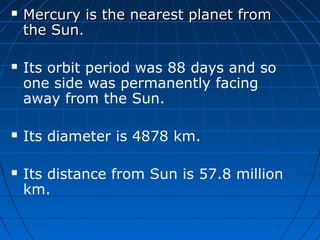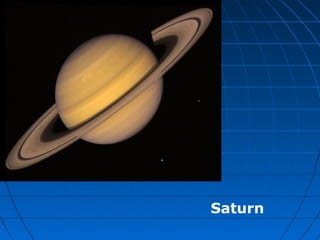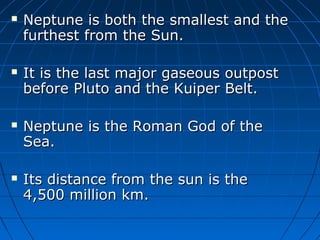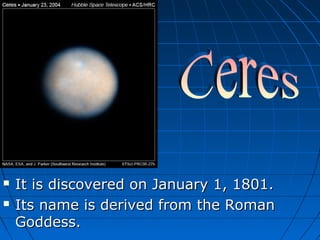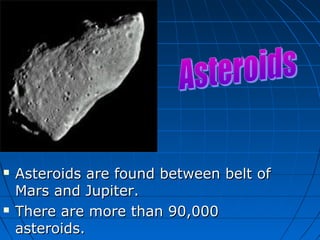Solarsystem ok
- 1. Solar System
- 2. The Sun
- 3. The Sun, a huge sphere of mostly ionized gas, supports life on Earth. The Sun is 332,900 times more massive than Earth and contains 99.86 percent of the mass of the entire solar system.
- 4. Planets
- 5. Mercury
- 6. Mercury is the nearest planet from the Sun. Its orbit period was 88 days and so one side was permanently facing away from the Sun. Its diameter is 4878 km. Its distance from Sun is 57.8 million km.
- 7. V E N U S
- 8. Venus is the second planet from the sun. Its name comes from roman goddess of beauty & love. Its diameter is 12,104 km. Its average distance from the sun is 108.2 million km.
- 9. Earth
- 10. The Earth is the third closest planet to the Sun. It is the only planet where the live happens. It consists Nitrogen (around 78%), followed by Oxygen(21%) and 1% of other gases. Its diameter is 12,756 km.
- 11. Mars
- 12. Mars is the fourth planet from the Sun. It is also known as Red Planet. It has the largest volcanic mountain in the Solar System. Mars has two natural satellites:Phobos and Diemos.
- 13. Jupiter
- 14. Jupiter is the fifth planet from the Sun. It is the largest planet of the solar system. Its four largest moons are:- IO, Europa, Ganymede, Callisto. Its magnetic field is 20000 times than the earth.
- 15. Saturn
- 16. Saturn is the second largest planet of the solar system. Saturn (the Roman God of Agriculture) has a diameter of 120,000 km. It has more than 30 moons. Its volume is 755 times than the volume of the earth.
- 17. U R A N U S
- 18. Uranus is the seventh planet of the solar system. It is the first planet which is found with the aid of the telescope. It has the 27 moons. Miranda is the strangest looking moon.
- 19. NEPTUNE
- 20. Neptune is both the smallest and the furthest from the Sun. It is the last major gaseous outpost before Pluto and the Kuiper Belt. Neptune is the Roman God of the Sea. Its distance from the sun is the 4,500 million km.
- 22. Pluto is the coldest dwarf planet.
- 23. It It It is the largest dwarf planet. has diameter of 3,000 km. is about 10 billion miles from Sun.
- 24. It is discovered on January 1, 1801. Its name is derived from the Roman Goddess.
- 25. Makemake is a creator god of Rapa Nui (Easter Island). It is the third largest known dwarf planet in the Solar System
- 26. Asteroids are found between belt of Mars and Jupiter. There are more than 90,000 asteroids.
- 27. Asteroids Too small & too numerous to be considered full fledged planets Most revolve around Sun between orbits of Mars & Jupiter= asteroid belt
- 28. the asteroid Ida and its newlydiscovered moon, Dactyl
- 29. Asteroid belt
- 30. asteroids
- 31. Meteors are also called Shooting Stars. 10,000 tons meteors are fall on the earth each day.
- 32. meteoroid meteor meteorite meteor shower
- 33. meteor
- 35. meteorite
- 36. A shooting star is really a meteor.
- 37. Comets take 30 million years to take a trip around the Sun. Each comet has a tiny part nucleus.
- 38. comet “dirty chunk of snowball” ice & dust orbitslong narrow ellipse
- 39. Parts of a comet coma nucleus outer layer inner layer tail formed by solar wind pushing gas away from the sun
- 41. Most comets- found in Kuiper belt (between Neptune & Pluto) or Oort cloud (beyond Pluto)
- 42. comet Pigpen from “Peanuts” Interactive Comet Animation
- 44. Comet HaleBopp in 1997 The passage of Hale-Bopp was notable for inciting a degree of panic about comets not seen for decades. Rumors that the comet was being followed by an alien spacecraft inspired a mass suicide among followers of the Heaven's Gate cult.
- 46. Comet Halley was visible in 1910 and again in 1986. The next time it will be visible will be in early 2062.
- 48. coma outer layer of a comet
- 49. “dirty snowball” Nickname for a comet
- 50. nucleus Inner layer of a comet
- 51. tail Formed by solar wind pushing gas away from the Sun
- 52. elliptical (ellipse) The shape of a comet’s orbit around the Sun
- 53. meteor A shooting star is really a ________.
- 54. asteroids Too small & too numerous to be considered full fledged planets
- 55. meteorite chunk of rock that lands on Earth’s surface
- 56. meteoroid chunk of rock or dust in space
- 57. Comets or asteroids Meteoroids usually come from________ or ___________.
- 58. friction causes meteoroids to burn up in the atmosphere
- 59. Halley’s Comet The comet that is observed from Earth every 76 years





